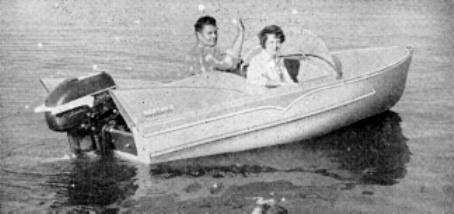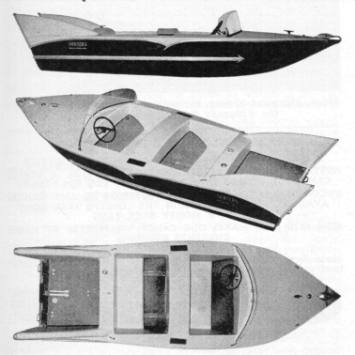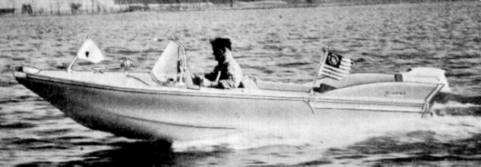By Lee Wangstad
No two people buy a boat for the same reason. It just doesn’t happen. For every boat and every owner, there comes a different rationale for the purchase. And how the buy came about in the first place might just have as much to do with happenstance as with any educated or methodical plan.

1957 Eldorado Rocket, 13′ 4″
When it comes to the boats built by George Herter, the decision to buy is usually an emotional one. One look at these boats and you either casually stroll away with a smirk on your face, shaking your head in disbelief, or else you walk away with a smile on your face, knowing that you’re going to buy this thing just because you know it’s going to be the coolest thing out there on the lake. If you have any control over your life at all, you find comfort in knowing that now is not the time to exercise it.
During the mid-fifties, when all of America was clamoring for a recreational outlet, George L. Herter produced a catalog for the outdoorsman that was second to none. No matter what outdoor activity you were interested in, Herter’s, Inc. had you covered. From hunting to fishing to camping to boating, George offered it all. And he offered it all UNCONDITIONALLY GUARANTEED! Unconditionally guaranteed to be of the highest quality, lowest prices, best workmanship, and on and on. And this unconditional guarantee came complete with a money back offer if not fully satisfied.
 1957 Duofoil Flying Fish Deluxe Model, 15′ 7″
1957 Duofoil Flying Fish Deluxe Model, 15′ 7″
“He first made the connection with fiberglass as a material for making duck decoys in the early 50’s,” remarks his son, Lance Herter. “He was always looking for new developments to improve his products.”
His first chrome fiberglass boats were duck boats and fishing boats which fit neatly into his sporting goods line. But as America became enamored with the idea of recreational boating, he expanded into the runabout market. He claimed in his catalog that he wasn’t in the boat building business to show a profit, but to keep his employees busy during the off season, so only a limited number of boats would be built each year. Whether he was serious or not, he definitely was selling boats! His first hot runabout, the Chrome Fiberglass Duofoil World Famous Deluxe Flying Fish, was introduced in 1956 and sported large (to say the least) cast aluminum fins bolted onto the rear deck of the boat. In 1957 the fins were fiberglass, molded integrally with the deck, and actually more pronounced than the previous year. By 1959 the fins had become much more streamlined, but compared to the rest of the market, they were still radical.

1960 Duofoil standard model Flying Fish, 15′
In addition to the Deluxe Flying Fish, Herter’s also produced a Standard Model Flying Fish, and a Mark III runabout. Perhaps the most elusive boat to collectors today has been the Herter’s El Dorado Rocket Chrome Fiberglass Runabout which appeared in 1957. This boat was “Guaranteed the fastest 13-1/2′ runabout made in the world.” It was made with a single seat that was claimed to be wide enough to hold three large people. Able to handle engines up to 75hp, this one definitely could fly.
What really placed Herter’s in a market of their own was the fact that it was basically a mail order package. You would order your boat through the mail or by telegraph and Herter’s would ship it out to you, either by truck or rail. Of course, you could always pick it up at the factory on one of their custom trailers. Herter’s had a number of plants scattered around the country, but most of the boat production took place at their plant in Waseca, Minnesota.
1960 Mark III Runbout 14′
Herter’s produced all of the unusual custom aluminum castings used on the boats. From the grab handles on either side of the front seat walk-through to the unique bow piece, all were made in-house. “He (George) was a great believer in making everything in his own plants,” says Lance Herter. “It was far less expensive to buy  raw materials than to buy product. That way you could produce just what was needed. You had real control over inventories.”
raw materials than to buy product. That way you could produce just what was needed. You had real control over inventories.”
By the early sixties Herter’s realized that their real market was in sporting goods and concentrated on the more utilitarian rowboats and duck boats. But George Herter’s experimenting with fiberglass was far from over. “He just had so many ideas for uses of fiberglass. He even covered an airplane with fiberglass. He never stopped thinking of new uses for the material,” says Lance Herter. “He had a unique ability to see the future potential in so many things, boats were just one of them.”

